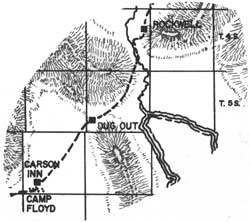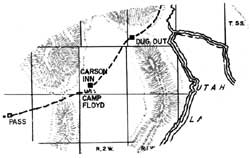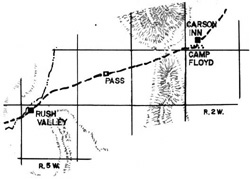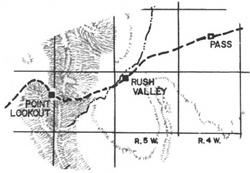|
The Pony Express Stations of Utah in Historical Perspective
|

|
THE STATIONS (continued)
Dugout (Joes Dugout, Joe Butchers)
Utah No. 11 Contract Station
 |
Location: SW1/4NE1/4 Section 30, Township 5 South, Range 1 West, Salt Lake Meridian. Eleven miles from Rockwell's Station. In conjunction with the Express and stage operation, Joseph Dorton operated a small grocery store. Clients were generally the soldiers from Camp Floyd. He also built a two-room brick home and log barn and provided a dugout for an Indian boy helper. Besides well water (Photo 16), water was hauled from Utah Lake and sold for twenty-five cents per bucket. [27] Use of the station after 1861 is unknown. It may have continued in use as a stage station. |

|
| Photo 16. Dugout Station's well site (from the Charles Kelly collection, Utah State Historical Society). |
Camp Floyd (Carson's Inn, Fort Crittenden, Cedar City, Fairfield)
Utah No. 12 Contract Station
 |
Location: NE1/4NW1/4 Section 32, Township 6 South, Range 2 West, Salt Lake Meridian (Figure 17).
Eight and one-fourth miles from Dugout Station.
The station was located within John Carson's Inn in Fairfield and saw use for both the Express and stage travel. The adobe building was built in 1858. It is still standing, has a wooden facade, and is open to the public as a Utah State Park (See Photo 17). It was operated by the family until 1947. Such personages as Horace Greeley, Mark Twain, Sir Richard Burton, Porter Rockwell, Bill Hickman, and General (then Colonel) Albert Johnston stopped at the inn.

|
| Figure 17. Carson's Inn (Camp Floyd). T. 6 S., R. 2 W., Sec. 32, 1856 Survey. (click on image for a PDF version) |

|
| Photo 17. Camp Floyd or Carson's Inn, Utah State Park, Fairfield, Utah (BLM photo 1977). |
In 1885, John Carson and his brothers, along with John Williams, William Beardshall and John Clegg, established Fairfield and Cedar City Fort. The latter was constructed as a private protective compound. It was adjacent to Fairfield that Camp Floyd, named for Secretary of War John B. Floyd, was established in November of 1858. Camp Floyd was the second military establishment in Utah and was commanded by Colonel Albert Johnston. (The first military reservation in Utah was established in Rush Valley, near present day Stockton, in 1853, by Colonel Steptoe. Its objective was to establish a military route to California and to investigate the Gunnison Massacre.)
Captain Simpson, Senior Engineering Officer at Camp Floyd, designed the overland stage route from Salt Lake City to San Francisco.
With a population of 7,000 — 3,000 of which were soldiers -- Fairfield was the third largest city in the territory. Boasting 17 saloons, wild Fairfield catered to soldiers and the army payroll.
East Rush Valley (Pass, Five Mile Pass, No Name)
Utah No. 13 Non-contract
 |
Location: NE1/4SE1/4 Section 16, Township 7 South, Range 4 West, Salt Lake Meridian. Ten miles from Camp Floyd. East Rush Valley Station, built as a dugout (See Photo 18), was listed by Howard Egan as being very active even though it is not identified as a contract station. The military road ran just to the south of the station, toward Vernon, and is still quite visible today. |

|
| Photo 18. Depression marking the site of East Rush Valley Station (BLM photo 1977). |
When in early 1861 Colonel Johnston left the Union to fight for the Confederacy, Colonel Phillip St. George Cook became the new post commander. The name was changed to Ft. Crittenden, but by May of 1861 the Fort was abandoned and ordered destroyed. By September of that year, Fairfield's population had dwindled to about 18 families. [28]
Rush Valley (Bush Valley, Faust, Doc. Faust's, Meadow Creek)
Utah No. 14 Contract Station
 |
Location: Lot 4, Section 5, Township 8 South, Range 5 West, Salt Lake Meridian.
Eight and three-quarter miles from East Rush Valley. (See Figure 18).
Although identified in the 1861 mail contract as Bush Valley, it is apparently a typographical error or was copied as a result of a misinterpreted hand-written contract. This station was established originally by George Chorpenning in late 1858. Within Utah (present boundaries), Chorpenning had built two relay stations, the one at Rush Valley called Meadow Creek Mail Station and the other at Smith Springs (Fish Springs). [29] There is a question whether the stone building still standing at Rush Valley is the station house (See Photo 19). The 1871 survey plat names this building Faust's House, while the survey notes call it Faust's Station. (See Figure 19). This building also has been called the old Fletcher house. We are told the remains of a depression marked the structure known as the station house. It was apparently evident for many years to the east and north of the present structure. [30]

|
| Figure 18. Faust USGS Quadrangle Map. (click on image for a PDF version) |

|
| Photo 19. Building at Rush Valley or Faust's. Note height of building and possible tack or feed storage area below the upper floor (BLM photo 1978). |

|
| Figure 19. Faust T. 8 S., R. 5 W., Sec. 5 1871 Survey. (click on image for a PDF version) |
"One of 'Doc' Faust's most pleasant remembrances while living at the station was the visit of Horace Greeley, editor of the New York Tribune, who was on a trip across the continent. Knowing that Mr. Greeley would very likely bury himself in books and not wish to carry on conversation, Mr. Faust took great care to see that all the tallow candles were hidden, leaving the house in darkness. Mr. Greeley, unable to read, then made a delightful companion for the remainder of the evening with interesting accounts of his travels." [31]
In 1870, Doc Faust moved to Salt Lake City and became engaged in the livery stable business. He later traded his ranch to O.P. Rockwell for 80 head of cattle. [32]
The field notes (survey records) of A. D. Ferron of October 1869 stated that there were two telegraph lines (from Salt Lake City) meeting at this location, one via Tooele and one via Camp Floyd to California.
The property, which includes the stone building and a cemetery, is under private ownership and is closed to the public. The monument north of the area, is misplaced and the log structure across the highway to the east is often referred to as "the original station."
Point Lookout (Lookout Pass, Jackson's)
Utah No. 15 Contract Station
 |
Location: NW1/4SE1/4 Section 13, Township 8 South, Range 7 West, Salt Lake Meridian.
Eight and one-fourth miles from Rush Valley.
Originally, Lookout Pass was identified by Simpson as General Johnston's Pass. The mail contract called it Point Lookout. From the top of the pass one can look west into the desert at what was to become known as Piute Hell. In May 1860, the Pah Ute War began, caused apparently because of white encroachment and depredations. For a short time, the Express was completely shut down (June-July). This "war" was finally settled after the Civil War when soldiers were sent west to quell the Indian uprisings.
An Egan employee, Fredrick W. Hurst, chronicles a station near the pass as being "Jackson's Station" in Brush Hollow. By 1876, the survey records show the site to be settled by Horace Rockwell (O.P. Rockwell's brother) and his wife, Libby (See Figure 20). Reportedly in 1885 and since about 1870, the Rockwells occupied a small log house, possibly the old station house. [33] A small cemetery plot, to the south, with iron railings apparently contains the remains of Rockwell's pet dogs. No other physical remains can be found at the site (See Photo 20).

|
| Figure 20. Point Lookout T. 8 S., R. 7 W. Sec. 13 1876 Survey. (click on image for a PDF version) |

|
| Photo 20. Dog cemetery or other structure at Point Lookout. |
| <<< Previous | <<< Contents>>> | Next >>> |
ut/2/sec2b.htm
Last Updated: 18-Jan-2008